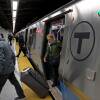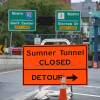The Sumner Tunnel has been fully closed for two weeks, as part of a planned two-month shutdown. While getting to Logan Airport has been more difficult for travelers from other parts of the city, East Boston residents have been living with the daily impact and adjusting their routines.
“I live day-to-day,” said Neelesh Batra, who is on the board of the Gove Street Citizen's Association. “People are making adjustments as we go.”
For people who live in Eastie, the Sumner shutdown isn’t brand new — weekend closures started in June of last year.
Batra said he’s become accustomed to adding about 30 minutes to car trips and checking the status of traffic frequently on Google Maps.
Margaret Farmer of the Jeffries Point Neighborhood Association, said there have been “significant fluctuations” in the length of her commute to Newton. She’s had days when it has taken an extra 20 minutes and days when it has taken an extra hour and 30 minutes.
“I ran into a neighbor and we were chatting and she changed jobs — to avoid having to drive,” said Farmer. “I think it's genius, actually.”
More Local News
Emergency response has also been a critical concern for Eastie residents during the tunnel closure. While East Boston Neighborhood Health Center recently completed renovations to its emergency department, there are concerns around treating cases of more severe trauma. The Ted Williams Tunnel closed twice last Thursday to transport organs to major hospitals.
Availability of ambulances is also a concern for those who need to get to a downtown hospital. Carlos Rosales, an East Boston resident who received a kidney transplant last November, expressed concern about how he would get to the hospital in current traffic conditions.
“I can't imagine if I was waiting for a transplant and I get the call at three in the afternoon on a Friday," he said. "I'm missing the window … I'm not getting there without a police escort or an ambulance.”
The increased number of idling cars in traffic has also left residents wondering about the impact on air quality.
“You can't mask it, it's there and it's constant and if you don't drive, you’re still going to breathe in that air because it's backed up into the community,” said Joanne Pomodoro, a community advocate. “It goes into all of what we breathe.”
Residents have access to some alternatives during the shutdown. The Blue Line is free, and there are reduced parking rates at Beachmont, Suffolk Downs, Orient Heights and Wonderland stations.

Lifelong East Boston resident Roxanne Curzi said the Blue Line has been running “pretty smoothly.”
”I've been using it more lately,” she said. But the gates are only open at the Blue Line, so if she transfers to a different line, “when I want to come home, I still have to pay.”
Five bus routes from Chelsea are free, while the 120, which runs between Orient Heights and Maverick, and 121 between Wood Island and Maverick, were not included in the mitigation plan as free routes.
The pilot East Boston Ferry service from Lewis Mall to Long Wharf is operating for free during the closure. The Blue Line also covers a similar route from Maverick to Aquarium station.
“The solution’s transit,” said Chris Marchi, a longtime community activist with Airport Impact Relief Inc., a neighborhood environmental organization. “And we can do it. But you got to make it a better option.”
He stressed expanding the Logan Express bus service as a possible solution to curbing airport drop-offs. Tickets for the Logan Express are 25% cheaper during the closure.
Marchi has lived in the neighborhood his whole life and says this shutdown has been another challenge.
“You know, most of the time neighborhoods in Boston, particularly East Boston, you know, they sort of take it on the chin and they roll with it … And this is a tough one to roll with.”









